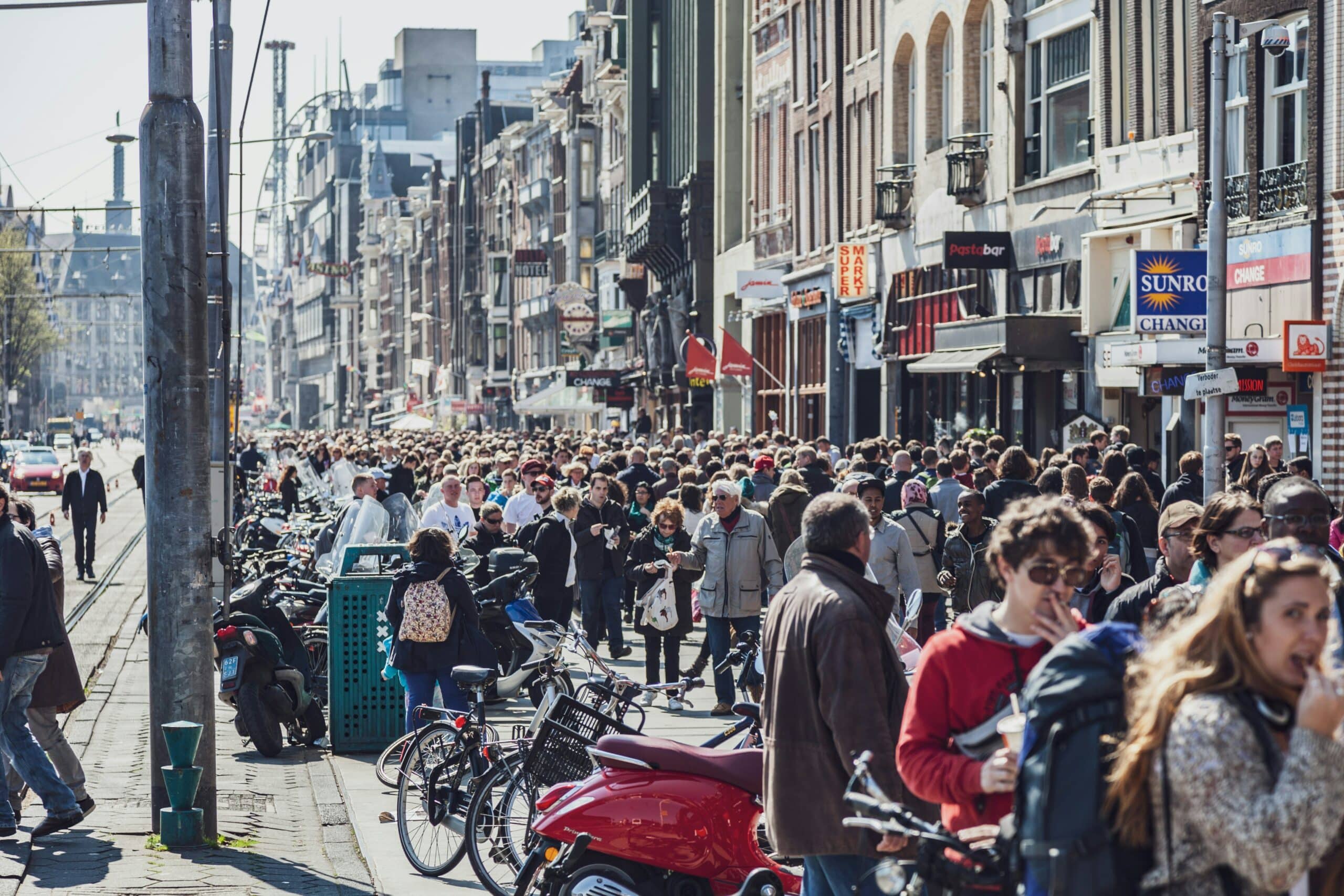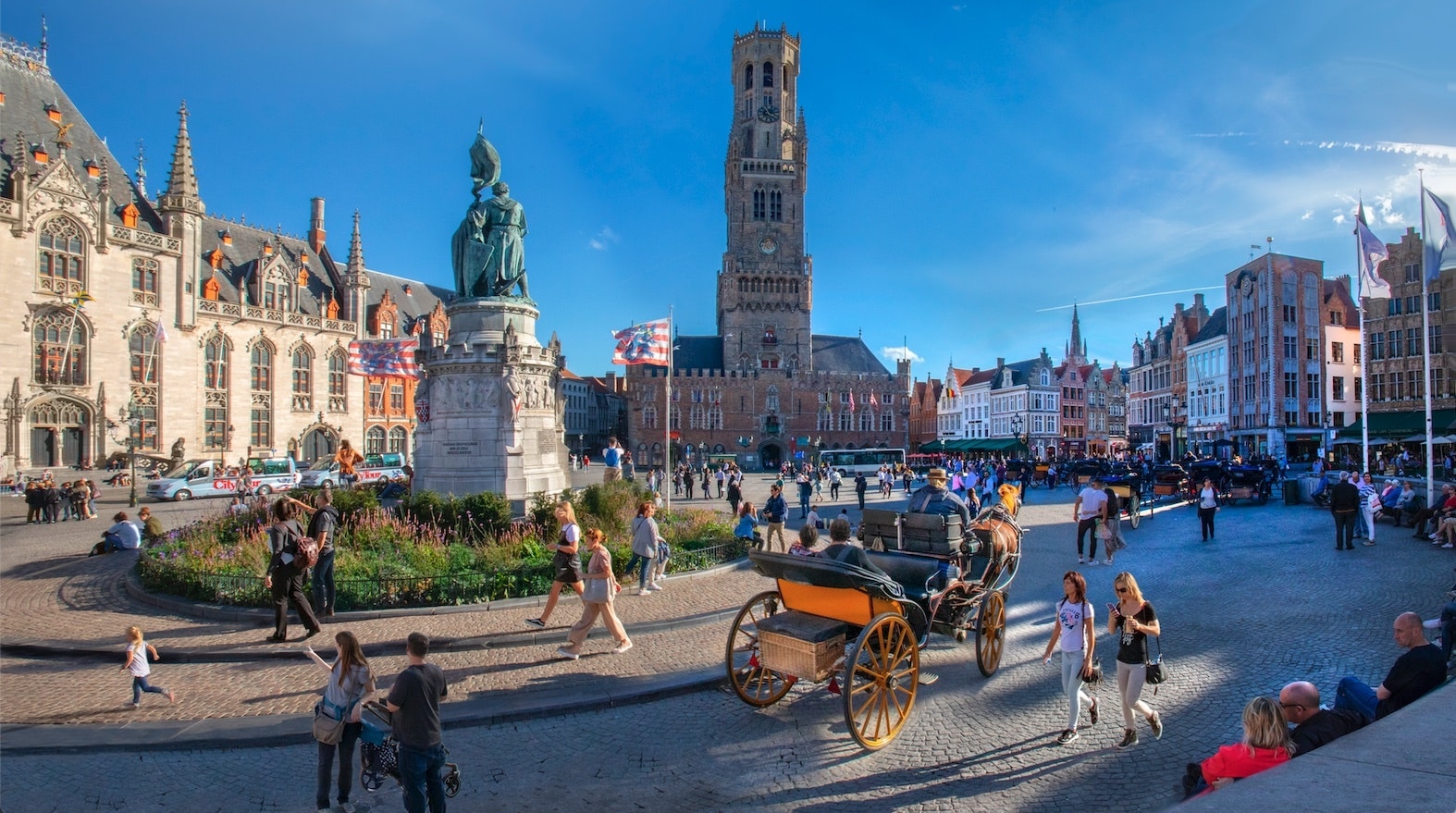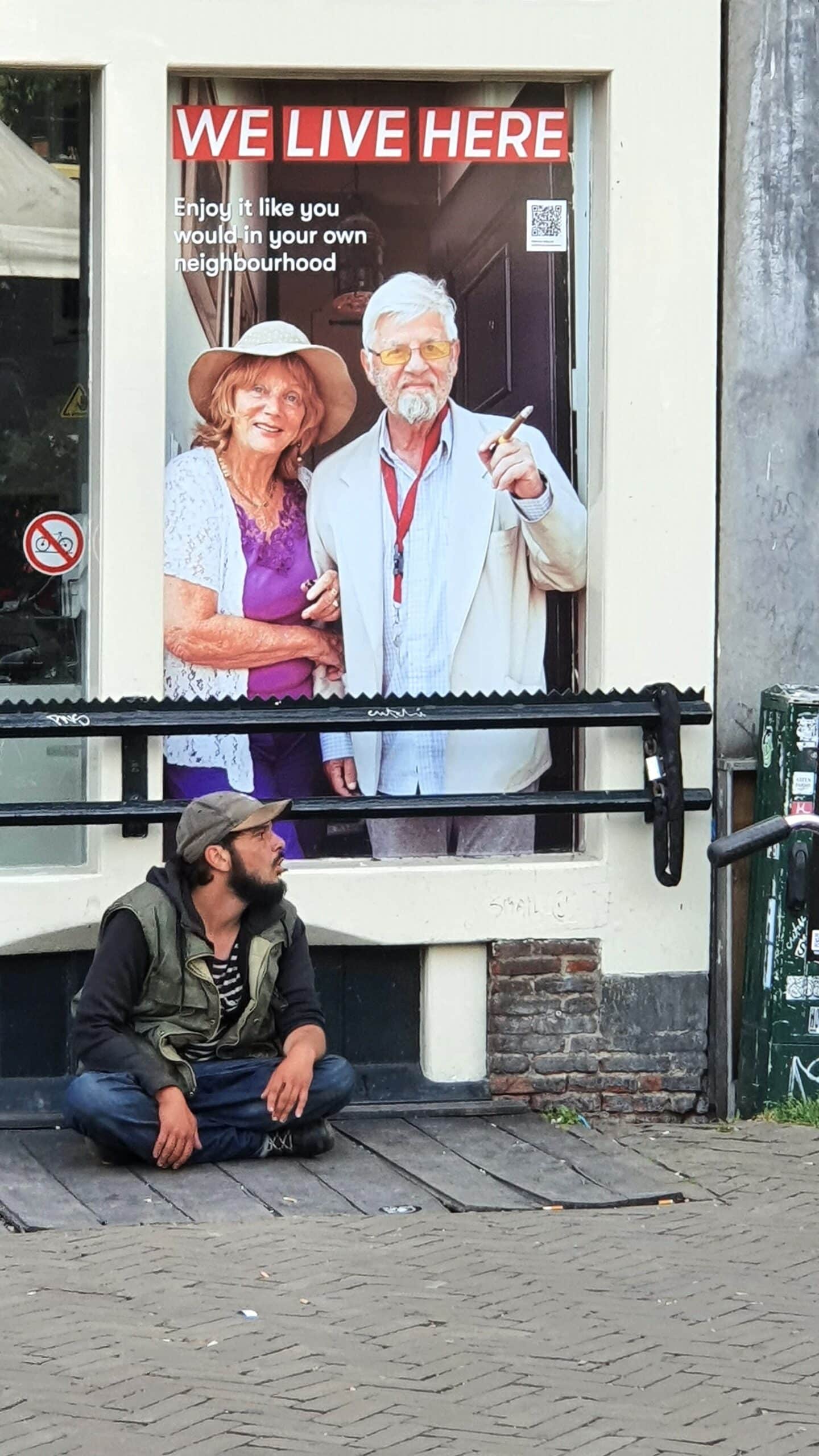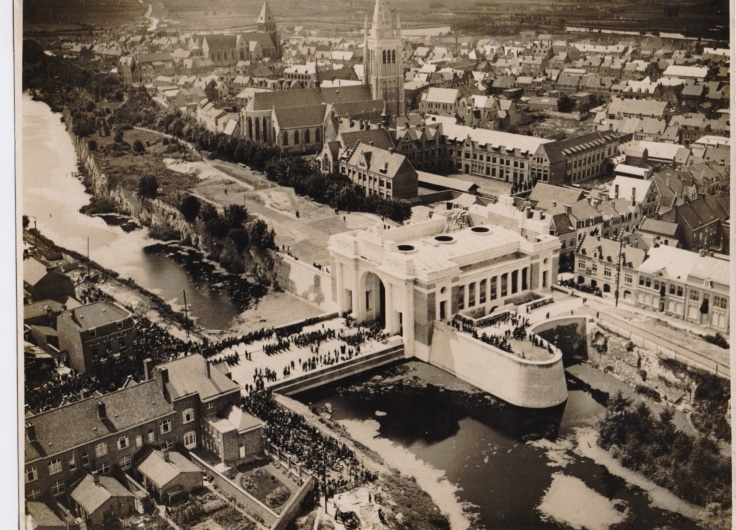This Is How Our Cities Are Tackling the Problem of Overtourism
The tourism industry in Belgium and the Netherlands has long since recovered from the COVID-19 pandemic, with visitor numbers even surpassing those of pre-2020. However, not everyone is happy with this development, as some destinations are now facing overtourism. How are the Low Countries addressing the growing call for sustainable tourism, while also providing benefits to the residents of popular cities?
The Rijksmuseum or the Stedelijk Museum were not yet on my list. I had gone for a beer in café Excalibur on the Oudezijds Achterburgwal street in Amsterdam. I was eighteen and my world had opened up. I vividly remember blaring Brits in front of a strip-tease bar, waiting for the doorman to let them in. In a thick Amsterdam accent, I heard him shout to his colleague: “Go on then, let the next load of idiots in.”
City marketing that worked too well
In his novel Filth (1990), Scottish author Irvine Welsh (Trainspotting) describes Detective Sergeant Bruce Robertson’s trips to The Dam in search of sex and drugs. The city is still carrying that reputation. In addition to that, the authorities pulled out all the stops after the banking crisis, to restore the international flow of visitors. They did this with the marketing campaign IAmsterdam, which has promoted the city since 2004. The tide turned entirely in the subsequent years, with up to thirty million expected visitors. In 2019, it led to the Stop the Madness in the Red Light District
campaign, and local government measures followed.
Had the amusement park closed? “It just opened again after COVID,” says Tom van der Leij, manager of the Amsterdam-based Toms Travel Tours, with which he organises very popular private tours. He watches the excesses from the front row. As a travel photographer who travels the world, van der Leij can make comparisons. He concludes that this kind of tourism doesn’t teach his fellow city dwellers anything. “I just received an application from India,” he says. Private Canal Boat Tour with Premium Alcohol (scotch) and Stripper Show. Entry to Banana Bar with 4 Drinks. Sex Museum. Rifle Shooting. Car Smash. Oil Wrestling. Foot Dart. Quad Bike. Axe Throwing. Private Beer Bike Tour (20 litres of beer).
“Should I continue? I haven’t included the dwarf tossing yet. I don’t even know if all those things exist. As a born and bred Amsterdammer, this is exactly what I want to get rid of.”
 "It's as if everyone now sees Amsterdam even more as an amusement park," Tom van der Leij of Amsterdam-based Toms Travel Tours said of the city after corona.
"It's as if everyone now sees Amsterdam even more as an amusement park," Tom van der Leij of Amsterdam-based Toms Travel Tours said of the city after corona.© Unsplash
Plans to discourage window prostitution in the Red Light District do little in terms of lowering visitor numbers. “It’s ridiculously busy there again”, says Van der Leij. “Note though, that all those ‘undesirable’ tourists are often young people, and we were all young once. As a city, you have to steer them in the right direction. But it’s like everyone considers Amsterdam to be even more like an amusement park now. Enforcement also appears to be lagging. Every entrepreneur in catering now also wants to earn money quickly. Masses of bars and terraces have been opened, and they are not going anywhere.”
Everyone wants to keep the peace
From my Ghent window, I can see the baroque curl of the Jesuit church. There are three blocks between me and the touristic heart of the city, with its shops and boat rental companies. Recreational pressure in Ghent remains under control, although there are signs beginning to crop up. Boat tourism is noise pollution, reads a sign on Sint-Antoniuskaai Street. According to a poll, one in three Ghent residents are no longer happy with tourists – more so than in Bruges. This used to be one in ten.
Tourism expert Jan van der Borg: "If you present yourself as an amusement park, you can’t get angry when people behave accordingly"
“We got used to the peace and quiet of COVID”, says Dutch economist and tourism expert Jan van der Borg, who is affiliated with the University of Venice and KU Leuven. Flanders and the Netherlands really want their tourists back. But this new tourism has to be “sustainable”. What does that mean? “According to the United Nations, ‘sustainable tourism’ is geared first towards the environment, then to companies, then visitors and lastly to residents. It should be exactly the other way around,” says Van der Borg. “Tourism development must become a means of qualitatively enriching a destination and creating employment, with residents as the most important stakeholders. It doesn’t matter how much money your visitors spend. Quality can also be things like young people living like ‘locals’, travelling during the off-peak season, or booking interesting accommodation. Amsterdam isn’t radical enough yet in these areas. Elsewhere, this change is happening more and more, says Van der Borg, who also adds that the Flemish thoughtfulness could sometimes do with a dash of Dutch decisiveness.
So it’s all about getting rid of beer bikes, Madame Tussauds, and the Amsterdam Dungeon then? “Position yourself as an art city. The sign IAmsterdam might stand for modernity and tolerance, but you have to market the city differently. Tourism is now so prevalent in Amsterdam that it suppresses other functions in the city. If you present yourself as an amusement park, you can’t get angry when people behave accordingly. Amsterdam and Bruges are equally affected by the selfie, bucket list and must-see culture, whilst Delft or Mechelen attract visitors with more awareness.”
Diversify, spread and involve
“Our art cities are our international assets, and we’re wholeheartedly promoting them”, adds Peter De Wilde, CEO of Tourism Flanders. “There can be friction in the areas where residents and visitors meet, but there are also opportunities for connection here. Encounters are preferably positive. ‘Tourists go home’ graffiti isn’t an example of a hospitable welcome, and in Flanders, we don’t want to let it get that far.”
In 2015, Tourism Flanders therefore began listening to residents in the art cities to poll their thoughts on the cities’ capacity for tourism. “Popular Dutch destinations like the Zaanse Schans, the windmill village of Kinderdijk and Giethoorn also saw the value in resident surveys like this. Our Dutch counterpart NBTC (Netherlands Bureau for Tourism & Congresses, WDH) started working on it together with the University of Leuven,” explains De Wilde.
The poll results deviated from perceptions. Flanders is still supportive, even in Bruges city centre – where it is assumed that it was too busy. “75% of residents consider tourism to be important both economically and as a citizen. So in Flanders, we’ve mainly been talking each other into thinking there’s a problem with overtourism. A successful destination is one that can maintain a balance whilst still offering growth opportunities.”
Peter De Wilde (Tourism Flanders): "In Flanders, we’ve mainly been talking each other into thinking there’s a problem with overtourism"
“At the same time, city marketing is very much necessary, because after two years of no communication we had a gap”, continues the CEO. “We aren’t Paris or London. In order to have constant visitor numbers all year round, we need to keep people’s attention permanently. Spreading out the peaks is also better for the hospitality industry, which is struggling to find staff. For each Flemish art city, we’re aiming at visitors who can find exactly what they are looking for there. And we’re aiming to have a lower carbon footprint in everything that we do. Tourism Flanders no longer works with low-cost airlines. We hope that we can inspire our huge number of partners to do the same.”
Business tourism: not business as usual yet
Brussels has been hip ever since the Belgian singer-songwriter Angèle sang ‘Bruxelles je t’aime’. In Sint-Katelijne, the Brussels neighbourhood that I called home for five years, you can see more cafe terraces than tourists. At the Oude Graanmarkt, where in the late nineties and early noughties there were only rough establishments like Chou de Bruxelles, there’s now a cocktail truck. With its tree-lined quays, this neighbourhood is a bit like Barcelona’s Las Ramblas. Better though, than the experiment around De Brouckèreplein, where the newly constructed pedestrian zone was in part to blame for the death of the distinguished Hotel Metropole. Brussels is often demi-demi, like the aperitif of the same name.
Jeroen Roppe (Visit Brussels): "We are still a long way from where Amsterdam or Barcelona are"
“We’re trying to find a new balance between week and weekend”, says Jeroen Roppe (Visit Brussels). For hotspots such as the Grote Markt and Manneken Pis, we’re implementing a spreading policy with incentives to draw tourists away from the very centre of the city to other areas. They are then more likely to go there on a second or third visit. Thanks to this spreading policy, you can see a shift from the Grote Markt to the Dansaertwijk and the Vismarkt. So lots of possibilities in the centre remain. We are still a long way from where Amsterdam or Barcelona are.”
Excursionism: the real problem
However, there is that one Flemish destination that had 7.9 million visitors in 2019 and – according to Professor Jan van der Borg – a few red flags were raised in the city centre. “Don’t compare Bruges with Amsterdam”, says tourism director Dieter Dewulf, in a beautiful office in the historic Sint-Janshospitaal. “The busyness of Bruges has to be considered in the right context. It’s not permanently busy here and it is not always because of tourists. We distinguish between day trippers, day tourists and overnight tourists. The first are visitors from the region who come to something like a market or a concert. The second are day trippers who spend at least an hour in the city. And the third are visitors who stay for at least one night. Our off-peak and peak months coincide with the holiday periods because Bruges is the biggest leisure city in Europe. 92% of visitors come for leisure. The peak is in summer and December, but Bruges still has off-peak moments during those busy periods – especially during the week.”
 Dieter Dewulf (Visit Bruges): “Most Bruges residents continue to embrace tourism"
Dieter Dewulf (Visit Bruges): “Most Bruges residents continue to embrace tourism"© Jan Dhondt
The problem is excursionism, Dewulf points out. “Visitors who stay elsewhere and only come here for a short while. Groups like cruise tourists all enter the city at once, at the same times of day and head to exactly the same places. This kind of tourism disturbs our residents, and that’s why we’re committed to spreading tourism over time and locations. We don’t limit cruises, but we have agreements with the port authorities about the number of calls and visitors per day. We want a balanced approach and that will increase local support for tourism. This is also apparent from our biennial residents’ survey. Most Bruges residents continue to embrace tourism.”
Bruges was an early pioneer of tourist management. “We’ve had restrictions on hotel and holiday home building since 2000 and 2002 respectively,” Dewulf explains. “Airbnb could never become a problem here. We were also the first to introduce a code of conduct for tourist tours.” The fact that the city is full of beer, chocolate and souvenir shops remains a sore spot. “If the residents of the city can’t find a baker or butcher easily anymore, then they leave. We think the societal price of that is too high. That’s why we’re now working on a legally sound framework to curb the supply that is currently too much in favour of tourism.” AKA: fewer waffle stalls wouldn’t be a luxury.
Raising awareness: sweeping your own porch first
Maybe the metaverse is the solution? If we all go on virtual trips, we no longer have to be annoyed by trolley suitcases, or messing with priceless heritage, like adding a visitor centre to the Gravensteen in Ghent. In any case, there seems to be a shift everywhere in our awareness of what a destination can handle. The Dutch NBTC’s Perspective 2030 talks about the sustainable development of the Netherlands as a destination, and the changing role that tourism will play. Just like in the Flemish vision of the future Traveling to Tomorrow, the key is broad collaboration with and support from the sector, government and now residents too.
 Residents of the Amsterdam Red Light District with a clear message to tourists
Residents of the Amsterdam Red Light District with a clear message to touristsTom van der Leij is happy to explain what this might look like in practice. 200 ice cream parlours, souvenir and waffle shops are spread out over Amsterdam’s tourist streets. “Local government no longer issues permits such business,” says Van der Leij. “As a resident, you should be able to use a shop yourself, which I also think should be the deciding criterion. Guided tours would also have a maximum of five people per group, which would limit the large-scale free tours, that visit all kinds of tourist shops. I limit my own groups to four participants, and I avoid peak crowds: my early bird tours are great because you have the city centre to yourself. You only see seagulls.”
Education is also a means, continues the Amsterdammer. “In the Red Light District, you see a photo of a resident who says: I Live Here. As a visitor, you should know that you’re in a place that residents are proud of. Our historical freedoms certainly appeal to the imagination. This is the first city to allow same-sex marriage. But you can’t just come and consume Amsterdam. We could communicate that kind of message in a video during a short-haul flight.”
There is already a tourist tax on overnight stays, but it shouldn’t stop there, says Van der Leij. “Tourism entrepreneurs are partly responsible. They have to clean up their mess every day and educate tourists. If we all sweep our own front porch first, we’ll have a big impact. And those who earn a lot from tourism should definitely have to pay extra tax on that.”






